- Submissions

Full Text
Environmental Analysis & Ecology Studies
Significant Human and Environmental Consequences of Traffic Noise in Jos, Nigeria
Haruna LZ1*, Fasakin JO2 and Emmanuel AA2
1Department of Urban & Regional Planning, Abubakar Tafawa Balewa University, Nigeria
2Department of Urban & Regional Planning, Federal University of Technology Akure, Nigeria
*Corresponding author:Haruna LZ, Department of Urban & Regional Planning, Abubakar Tafawa Balewa University, Nigeria
Submission: July 03, 2023; Published: July 28, 2023

ISSN 2578-0336 Volume11 Issue3
Abstract
This paper investigated the significant human and environmental consequences of traffic noise in Jos, Nigeria. Subjective noise responses data of the respondents exposed to road traffic noise was collected using a structured questionnaire. A total of 1,135 copies of the questionnaire representing 0.5% of the total household heads in Jos metropolis were administered during the field survey. The questionnaire was self-administered and with the help of field assistants at random to the respondents. The questionnaire contained some opinion questions on the effects and consequences of traffic noise on human and environment. Five medical doctors in some of the public and private hospitals in Jos metropolis were interviewed to obtain their expert’s views on the effects and consequences of road traffic on human health and wellbeing using Key Informant Interview (KII) guide. The data obtained was analyzed using descriptive statistics and regression analyses. The findings revealed that, there was a significant and positive relationship between road traffic noise and human and environmental consequences in Jos (r=0.556, p< 0.05). It further revealed that hypertension, hearing impairment and CVD cases were highly prevalent in Jos. This paper, therefore, recommends among others planting of trees, shrubs and vegetations along the roadways to serve as buffer (barrier) against road traffic noise pollution being emanated by the moving vehicles thereby mitigating the impact of noise pollution on the affected residents.
Keywords:Consequences; Environmental; Human; Jos metropolis; Noise levels; Traffic
Introduction
Worldwide, cities seek to create more sustainable urban transport systems aimed at reducing accidents, congestion, air, and noise pollutions to improve social interactions, livability and amenity (Yu, 2017). These cities, as centers of economic, social, and political lives of nation-states, share to some extents, distinctive features of urban areas which are essential: denser populations, predominantly built-up areas, mixed land-use, frenetic pace of human activity, and extensive transportation infrastructure (Aliyu & Amadu, 2017). Ironically, these same features which sustain city life and competitiveness, also pose risks to human health and wellbeing (Gruebner et al., 2017). For instance, road traffic noise in large cities across the world has in recent times become an issue of great concern because it constitutes the major proportion of environmental noise (Paiva, Cardoso & Zannin, 2019). Noise pollution in urban areas is considered as the third most hazardous type of pollution right after air and water pollutions, much of this noise is road traffic-related [1]. Traffic noise pollution lowers the quality of life and property values for a person residing in the vicinity of these urban corridors (Wang, Chen & Cai, 2018). The exposure to harmful noise level is greater in developing countries such as Nigeria, India, China, and others (Pathak et al., 2018). This could be attributed to ineffectual planning and poor noise management strategies (Chaichan, Kazem & Abed, 2018).
The effects of traffic noise on human health and wellbeing are categorized into four depending on the period and volume which an individual is exposed to including physical, such as hearing defects; physiological, such as increased blood pressure, irregularity of heart rhythms and ulcers [2]; psychological, such as disorders, sleeplessness and going to sleep late, irritability and stress [3]; and effects on work performance, such as reduction of productivity and misunderstanding what is heard (Vibhav et al., 2018). Road traffic noise has in recent times become a global issue. For instance, the World Health Organization report estimates that about 65% of the population in Europe resides in places where they are regularly exposed to unacceptable noise levels (Paiva, Cardoso & Zannin, 2019). Similarly, in Hong Kong, about 80% of the population is affected by road traffic noise to a large extent (Wong et al., 2019). In India, about 60-85% of people opined that vehicular road traffic was a major source of noise pollution and creates annoyance among them [4]. According to Bhaven (2011), traffic-related noise pollution accounts for nearly 67% of the total noise pollution in an urban area.
The problem of road traffic noise has become an issue of great concern in Nigeria. Several studies have reported that road traffic noise level in many Nigerian cities exceed standard limits specified by the Federal Environmental Protection Agency (FEPA) and the World Health Organization (WHO) [5]. For instance, studies conducted by Adeke et al. [6]; Okeke et al. [7]; Anomohanran [8]; Oyedepo et al. [9] on road traffic noise level found that, the noise pollution level in their respective case studies were higher than the safe threshold of 55dB(A) as specified by FEPA and WHO. Similarly, in a study conducted by Okokon [10] to investigate patterns of travel-mode-specific exposures to road traffic noise and air pollution in three European cities and a Nigerian city, reported that commuter and community exposure to road traffic-related noise and air pollution was higher in Lagos city, Nigeria. Also, Obisung et al. [3] in a study of five selected cities in eastern Nigeria, found that the majority of the city dwellers suffer serious sleep disturbances due to road traffic noise.
The Nigerian government, through the Federal Ministry of Environment under the National Environmental Standards and Regulations Enforcement Agency (Establishment) Act 2007, establishes a comprehensive environmental policy known as the Noise Standards and Control Regulations, 2009. The goal of the document is to ensure the maintenance of a healthy environment for all people in Nigeria, the serenity of their surroundings and their psychological well-being, regulating noise level by prescribing the minimum permissible noise level; Providing for the control of noise, and for mitigating measures for the reduction of noise. However, despite the existence of such policy and laws to address noise pollution in Nigeria, noise pollution, especially from road traffic in many cities such as Jos, has been on the increase in recent times. This could be attributed among others to the lack of proper implementation of the relevant policies and laws or lack of database information on the level of traffic noise. Environmental noise has been progressively increasing over the previous few decades, and it is now a major social concern [11]. Environmental noise is hazardous not just to humans, but also to wildlife. Because some animals are particularly sensitive to sound, manmade noise pollution can have an impact on how they interact, mate, and hunt. Exposure to excessive amounts of environmental noise on a regular basis can be damaging to one’s health and well-being. Medical expenditures, higher mortality, productivity loss, activity reduction, and a decline in the prices of homes and landed properties are all direct and indirect economic repercussions of both effects on society.
Long exposure to excessive road traffic noise and other noisegenerating sources has many adverse effects on human health and wellbeing [12]. For instance, excessive road traffic noise exposure may cause deafness, nervousness, breakdown, mental disorder, high blood pressure, headaches, dizziness, inefficiency, and insomnia [13]. Similarly, Dasarathy et al. [14] reported that even a relatively low level of noise adversely affects human health. For instance, it causes hypertension, disturb sleep, and hinder cognitive development in children [2]. The effects of excessive noise exposure could be so severe to the extent that either a permanent loss of memory or a psychiatric disorder might occur [15]. However, little efforts have been made to investigate the consequences of road traffic noise on the environment and human health and wellbeing in Nigeria, particularly in Jos metropolis. Therefore, this paper intends to investigate the significant human and environmental consequences of traffic noise in Jos, Nigeria.
Materials and Method
The study area
The study was conducted in Jos metropolis which comprised of Jos North and Jos South Local Government Areas of Plateau State, Nigeria. Assumptions were made before selecting the study area. First, the study area being the state capital is one of the major cities in Nigeria which serves as a center for commercial, political, residential, industrial, administrative, educational, and others should be sensitive to different land-use developments. Second, the study area created good opportunity to establish reliable database on the volume of road traffic, level of road traffic noise and residents’ dispositions to road traffic noise pollution.
Geographically, Jos North is located between latitude 9o 55’N and longitude 8o 54’E. It is a heterogeneous Local Government Area and has a total land mass of 291km2 and a population of 437,217 (NPC, 2006). Jos South is located between Latitude 9o 46’N and Longitude 8o 43’E. Its headquarters is located in Bukuru town and it has an area of 510km2 with a population of 311,392 as at the 2006. The metropolis is a hub for political, economic, industrial, educational and administrative activities in the state. The present total estimated population of Jos metropolis stands at 1,134,806. As the city continues to increase in size and population, traffic volume and its associated challenges such as noise and air pollution becomes a major challenge to the residents and passer byes (Figure 1 & 2).
Figure 1:The study area in its regional setting.
Source: Plateau state ministry of housing and urban development (2019)
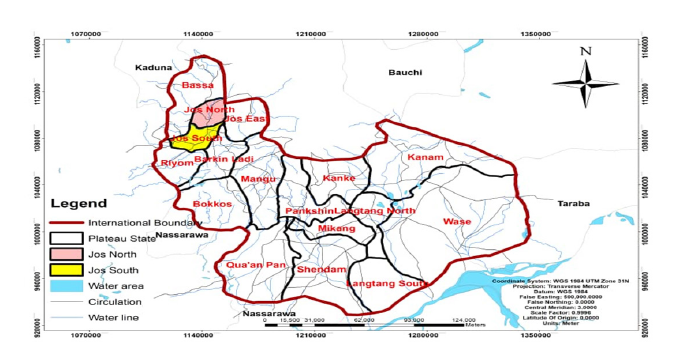
Figure 2:The study area in its local settings.
Source: Plateau state ministry of housing and urban development (2019)
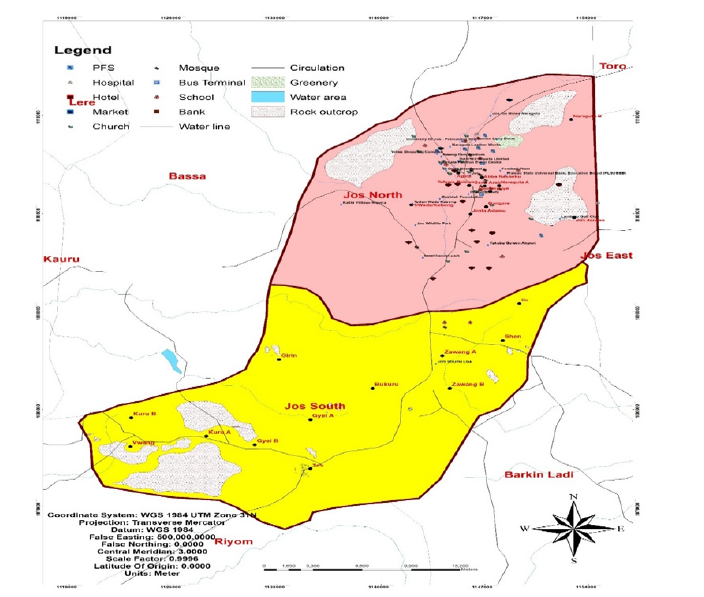
Method of Data Collection
This research adopted a survey research design [16]. Both quantitative and qualitative approaches were employed to carry out the study. The population for the research was the entire residents of Jos metropolis. This research targeted those residents who have lived in Jos metropolis for a minimum of two years. A total of twenty-six (26) wards located along roads and streets in Jos metropolis represented the sample frame for the study. Jos metropolis was selected for the study because it serves not only as the state capital, but also as the center for commercial, political, residential, industrial, administrative and educational activities, among others and therefore, should be sensitive to different landuse developments. This study employed both stratified random sampling and simple random sampling techniques for data collection. Stratified random sampling was used to divide the study area into strata (wards). A simple random sampling was used to select the required sample size for the study from each ward (stratum) in the study area to examine their perception of the risk of exposure to road traffic noise. The sampling for the respondents was done such that, it captures the respondents (residents) within a specific radius from a given road or street (measurement points) in the study area. The sample size for this research was guided by the concepts and views of other researchers in similar studies for a more rational sizing. this research imitated the random selection of 0.5% of the population of household heads in each ward (stratum). A total of 1,135 copies of questionnaire which represent 0.5% of the total household heads (respondents) in Jos metropolis were administered during the field survey. The questionnaires were administered to the household heads (respondents) and their representatives proportionate to the population represented by each ward in the study area.
Subjective noise responses data of the respondents exposed to road traffic noise was collected during weekends to ensure maximum participation using a carefully constructed structured questionnaire titled - Road Traffic Noise Level Questionnaire (RTNLQ). The questionnaire was self-administered and with the help of some trained field assistants at random to residents of neighborhoods and communities, adjacent to the selected roadway locations. The questionnaire contains some opinion questions under various sections. The section on demographic/socioeconomic information elicits data on respondent’s sex, age, marital status, educational level, occupation, vehicle ownership, income level, among others. Further investigation on the consequences of road traffic on their health and wellbeing, experts’ opinions were done using five medical doctors in some of the public and private hospitals in Jos metropolis such as the Jos University Teaching Hospital (JUTH), Plateau State Specialist Hospital (PSSH), Bingham University Teaching Hospital (BUTH) and Our Lady of Apostles (OLA) Hospital respectively. Their opinions were obtained during an interview using Key Informant Interview (KII) guide. Of the five (5) experts interviewed, three (3) were Ear, Nose and Throat (ENT) specialist and two (2) from Psychiatric departments respectively.
Key Informant Interview (KII) is a qualitative in-dept interview with people (mostly experts) who are knowledgeable about what is going on in the community or their areas of expertise in order to collect first-hand information. In this study, the key informants were selected based on their professional skills, areas of expertise, and or positions in their respective hospitals such that they provided more information and a deeper insight on the effects and consequences of traffic noise on human health and wellbeing. The study employed Key Informant Interview (KII) technique because the conditions attached to the collection of data by the public and private hospital authorities were prohibitive, expensive and cumbersome to meet. These conditions included ethical clearance, submission of the research proposal (3 to 12 hard copies), application processing fee between Ten to Twenty thousand naira (10,000-20,000), application letter, consent form and cover letter among others (see attached appendix). KII has been widely used and is still being used in both medical and non-medical research studies (Yu et al., 2019; Nadrian et al., 2020 & Sprague Martinez et al., 2020). The languages of the questionnaire administration during the survey were Hausa, Pidgin, and English to overcome communication barriers during the survey. In the course of administering the questionnaires and interview guide, urban residents were asked about their experience and perceptions as it relates to road traffic noise within their area of residents.
Research Findings and Discussion
Human and environmental consequences of road traffic noise in Jos metropolis
Awareness of road traffic noise in the study area : Table 1 presents the respondents’ awareness of the human and environmental consequences of road traffic noise in the Jos metropolis. Data collected indicated that, the majority (32.8%) indicated that they were often aware of road traffic noise around them; 26.1% indicated always; 19.5% said sometimes; 15.4% agreed rarely and 10.3% responded not at all. The deduction from this finding is that, most residents of Jos metropolis were sensitive to road traffic noise pollution in their vicinity, its consequences on their health and environment. The level of noise awareness by individuals varies greatly among the people. Noise awareness is often influenced by certain attributes such as the intensity of the sound, individual interest in a peculiar sound, sensory adaptation to noise, quality and context of the sound stimulus, among others. Therefore, these attributes determine individual’s reaction to noise.
Table 1:Awareness of road traffic noise in the study area.
Source: Field survey, 2021
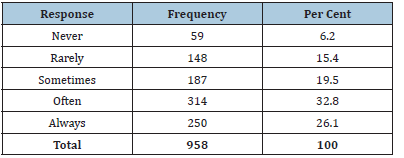
This result contradicts surprisingly with the findings of Emenike et al. [17] and Okeke et al. [7], who found that the majority of the residents in Port Harcourt metropolis are not aware of road traffic noise pollution despite its negative effects on their health and wellbeing such as; sleeping disturbance, high blood pressure, headache, dizziness among others. Similarly, in a study conducted by Orie [18], it was reported that a lack of awareness of the impact of noise pollution on humankind and the environment is attributed to the absence of public education on the effects of noise pollution by the relevant agencies. For instance, the residents revealed that, they have never been educated on the effects of noise pollution on their health and wellbeing and the ways for minimizing it. The unawareness of the majority of the residents in Port Harcourt metropolis of road traffic noise pollution despite its negative effects on their health and wellbeing can be attributed to the lack of public education on its medical, psychological, physiological and mental consequences among others.
Annoyance to road traffic noise: When the respondents were asked whether they feel annoyed by road traffic noise, 56.0% indicated that, they were annoyed with road traffic noise; 19.1% could not say how annoyed they were and 24.9% indicated that, they were not annoyed with road traffic noise as presented in Table 2. The results revealed that most of the respondents were extremely annoyed with road traffic noise. An annoyance is a human feeling of displeasure or adverse reaction triggered by anger, disappointment, anxiety, and depression in general. This variable shows respondents’ opinions on annoyance with road traffic noise such as; not annoying, cannot say, and yes annoying. The extent of individual annoyance by traffic noise is influenced by its level. The higher the noise level, the more people are annoyed and the greater the severity of the perceived annoyance. Okokon et al. [19] also found that a large population of Finnish adults were highly irritated by road traffic noise and consider it as a health hazard.
Table 2:Annoyance to road traffic noise.
Source: Field survey, 2021

Table 3:Sleep disturbance caused by road traffic noise.
Source: Field survey, 2021
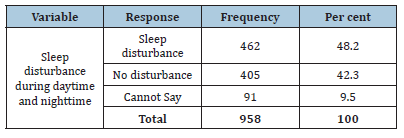
*Day - 6:00am - 10:00Pm, Night - 10:00pm-6:00am
Sleep disturbance caused by road traffic noise: When asked if road traffic noise wakes them up during the day and night, majority of the respondents, 48.2% said yes, 42.3% said no disturbance, and 9.5% said they could not say anything (Table 3). The rating of traffic noise disturbance depends on some certain personal attributes such as individual temperament, cognitive style, state of mind and health, level of control over the sound stimulus, attitude towards the sound source, time of the day and others. Niemann and Maschke (2004) reported that road traffic noise is one of the leading causes of sleep disruption among city dwellers. Also, Ogunseye et al. [2] reported that, even a relatively low level of noise causes sleep disturbance, hypertension, and hinder cognitive development among children.
Effect of road traffic noise on human health and wellbeing: When the respondents were asked whether they experience any kind of noise-induced health challenges or have any health problems due to night sleep interruption, 47.2% said yes; 39.2% said no; and 13.6% indicated not sure. Out of the 452 who opined that, they experience some kind of noise-induced health challenges, 21.9% admitted that they experienced or suspected high blood pressure; 14.8% said hearing an increase in heartbeat; 28.1% hinted feeling depressed mood when they heard the noise; 33.2% said feeling headache and 2.0% indicated other ailments (Table 4). Road traffic noise is associated with a wide range of effects on human health and well-being. Human health challenges such as hearing defects, increased blood pressure, irregular heart rhythms, ulcers, disorders, sleeplessness and going to sleep late, irritability, stress, ischemic heart diseases, angina pectoris, myocardial infraction, and others have been linked to high exposure to road traffic noise. Analysis revealed that, most of the respondents had experienced one form of sickness or the other. This could be attributed to the high levels of traffic noise recorded in the study. The finding is reflective of the medical prevalence of sicknesses in Jos noticed during visitation to some hospitals in Jos such as; Plateau State Specialist Hospitals and Jos University Teaching Hospitals.
Table 4:Effect of road traffic noise on human health and
wellbeing.
Source: Field survey, 2021
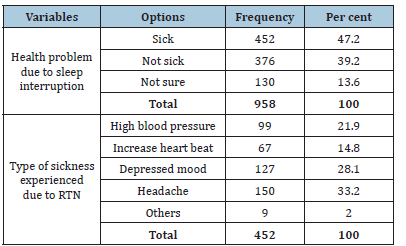
Okokon et al. [12], Ogunseye et al. [2] and Akinkuade et al. [13], reported that, long-term exposure to excessive road traffic noise and other noise-generating sources has many negative effects on human health and wellbeing such as hypertension, disturbed sleep, deafness, nervousness, breakdown, mental disorder, high blood pressure, headaches, dizziness, inefficiency, insomnia, and impaired cognitive development in children. Also, Cai et al. [15] reported that excessive noise exposure could be so severe to the extent that either a permanent loss of memory or a psychiatric disorder might occur. Similarly, Dasarathy et al. [14] reported that even a relatively low level of noise adversely affects human health.
Mean and standard deviation of environmental attitudes: From Table 5, all the items of environmental attitudes had a mean rating above 3.50. These include; people needlessly worrying about traffic noise in their environment (3.58), road traffic noise as a major source of environmental noise (3.53), exaggeration of traffic noise threats (3.69), enjoyment of a noisy environment (3.55), bad feeling in a noisy environment (3.65), the metropolis is generally quiet and a place to be (3.68), and a noiseless environment for healthy living (3.62). Others include; satisfaction with a quiet environment (3.84), the general environment (3.95), and people’s feeling more comfortable in quiet areas than in noisy environments (3.86). All these were contrary to what Emenike et al. [17], reported that the majority of the respondents in Port Harcourt metropolis, covering about 64%, were not satisfied with the noise level in their environment. The health and wellbeing of residents depend on the overall quality of the urban environment in which they live, work and recreation. Road-traffic noise has been regarded as the principal source of community noise, although there can be other significant sources. Understanding traffic as the major source of community noise is key to assisting policymakers in making decisions aimed at improving road traffic noise pollution management and reduction.
Table 5:Mean and standard deviation of environmental attitudes.
Source: Field survey, 2021

Correlations between mean RTN level and Humanoenvironmental consequence in Jos: The Spearman’s rho correlation coefficient was used to investigate the relationship between RTN level and humano-environmental consequence. Preliminary analyses were performed to satisfy the assumptions of normality, linearity, and homoscedasticity. The correlation analysis between RTN level and humano-environmental consequence in Jos is presented in Table 6. There was a significant and positive relationship between road traffic noise and humano-environmental consequences in Jos (r =0.556, p<0.05). As a result, the null hypothesis, stating that there is no significant relationship between mean RTN level and humano-environmental consequences in Jos, was rejected. The implication of this result is that an increase in road traffic noise tends to have increased human and environmental consequences.
Table 6:Correlations between mean RTN level and Humano-environmental consequence in Jos..
Source: Field survey, 2021

Regression analysis of the relationship between RTN and human and environmental consequences of road traffic noise: A simple linear regression was carried out to test if RTN significantly predicted humano-environmental consequences. Table 7 presents the regression analysis of the relationship between RTN and humano-environmental consequences. The R-square value of 0.375 indicates that RTN accounted for 37.5% of the humanoenvironmental consequences in Jos. The F (1, 376)=225.806, p<0.05, indicates that the model is significant. The standardized coefficient (b=0.613, P<0.05) showed that RTN has a positive and significant effect on humano-environmental consequences in Jos. Thus, the null hypothesis was not supported. The implication of this result is that, RTN increases, will bring a corresponding increase in human-environmental consequences.
Table 7:Regression Analysis of the relationship between RTN and Human and Environmental Consequences of road
traffic noise.
a. Dependent Variable: humano-environmental consequence, b. Predictors: (Constant), RTN
Source: Field survey, 2021

Common diseases associated with traffic noise in particular: Experts were asked to share their opinions on the common diseases associated with traffic noise in particular. According to Table 8, five (5) experts opined that sleeplessness/insomnia is linked to traffic noise. Three (3) indicated that stress, annoyance, noise trauma, headache, tinnitus, and hearing impairment are associated with traffic noise. Two (2) indicated that, learning difficulties, speech abnormalities, and inefficiency are associated with traffic noise. Other sicknesses linked to traffic noise included diabetes, cardiovascular diseases and vertigo. All the experts considered sleepless/insomnia as the most common diseases associated with traffic noise. The implication is that most of the residents of Jos metropolis might have experienced sleeplessness as a result of high traffic noise levels which could have great impact on their quality of life and their wellbeing. Shin et al. [20], Gilani et al. [21] and Wang et al. [22], reported that long‐term exposure to road traffic noise was associated with an increased incidence of diabetes mellitus, hypertension, hearing impairment, cardiovascular diseases, insomnia, stress disorders among others.
Table 8:Common diseases associated with road traffic noise in particular.
Source: Field survey, 2021
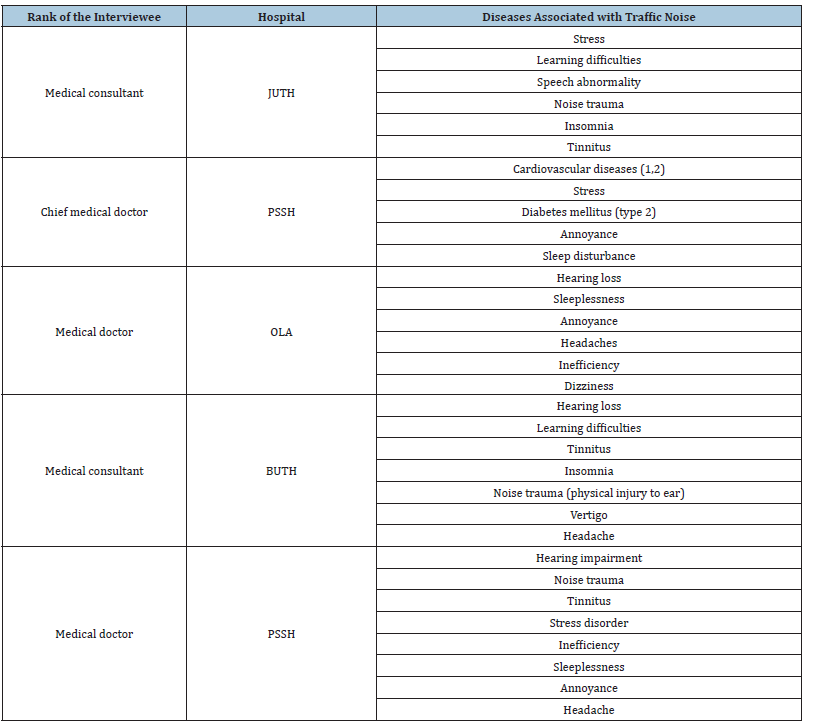
Consequences of traffic noise on human health and wellbeing: On the consequences of traffic noise on human health and wellbeing, five (5) indicated CVD, four (4) indicated noise trauma, three (3) indicated depression and two (2) indicated stress and heart condition as some of the consequences of traffic noise on human health and wellbeing. Other consequences included increase in hypertension risk, myocardial infarction, psychological ill health, weight gain, anxiety disorder, low quality of life, socioeconomic deprivation, economic viability of the society, job loss and unemployment as indicated in Table 9. This indicated that all the experts considered CVD followed by noise trauma as the major consequences of traffic noise on human health and wellbeing. The implication is that those whose health have been affected by traffic noise regularly visit hospitals for medical check and this can lead to socio economic deprivation which in turn leads to low quality of life.
Table 9:Consequences of road traffic noise on human health and wellbeing
Source: Field survey, 2021
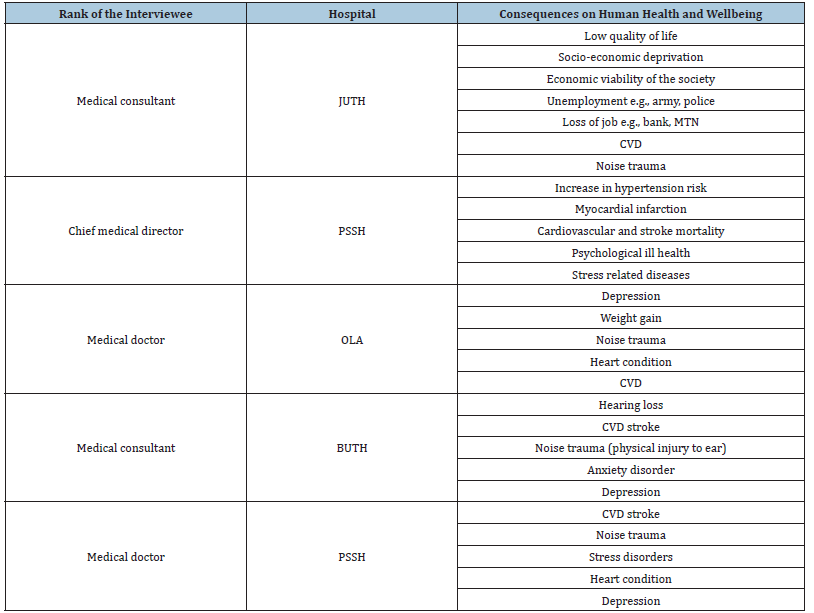
Bustaffa et al. [23], Tong et al. [24], Clark et al. [25], Von Szombathely et al. [26], Roswall et al. [27] and Welch et al. [28] held that Low quality of life, socio-economic deprivation, economic viability of the society, unemployment, loss of job, increase in the cases of hypertension, cardiovascular diseases, CVD, noise trauma, diabetes mellitus, hearing loss stress related disorders and depression among others are some of the major consequences of traffic noise on human health and wellbeing.
Noise related sicknesses that were prevalent in Jos metropolis: Table 10 presents the results of experts’ opinions on the prevalent noise related sicknesses in Jos metropolis. Most of the experts indicated that, hypertension, hearing impairment and CVD cases were highly prevalent in Jos. Other noise related sicknesses that were considered prevalent include among others tinnitus, cardiovascular diseases, noise trauma, diabetes, vertigo and Stress related diseases. Hypertension was considered highly prevalent in the study area followed by hearing impairment and CVD. The implication is that hypertensive people were mostly linked to low life span. Recio et al. [29], Shin et al. [20], Hegewald et al. [30], Wang et al. [22] Gilani et al. [21], Smith et al. [31], who reported that, long-term exposure to excessive road traffic noise has many negative effects on human health and wellbeing such as; hypertension, hearing impairment, tinnitus, cardiovascular diseases, CVD stroke, noise trauma, vertigo, insomnia, and impaired cognitive development in children among others [32-40].
Table 10:Noise related sicknesses that were prevalent in Jos metropolis
Source: Field survey, 2021
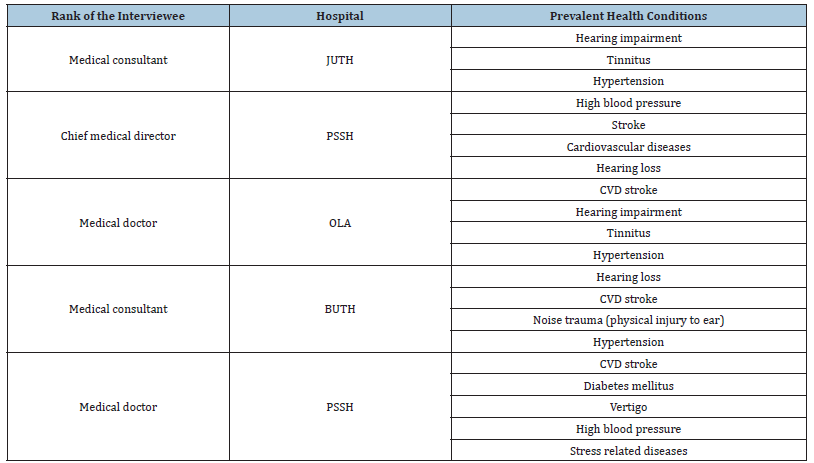
Recommendation
Considering the findings of this study, the following recommendations are put forward: traffic rules and regulations and traffic calming strategies among others should be properly enforced by the relevant authorities to ensure effective and efficient noise pollution management in Jos. Noise sensitive environments such as schools, residence, hospitals, and public areas should have minimal threshold noise levels [41-45]. The spaces available along the roads sides should be devoted for green space that can serve as a buffer (barrier) against road traffic noise pollution being emanated by the moving vehicles. Dense vegetation cover of broadleaf and needle leaf types such as Platanus and Acacia should be used for this purpose. A public massive enlightenment and awareness campaigns on the adverse effects of road traffic noise pollution on environment and human health and wellbeing should be regularly carried out by the government in collaboration with other concern agencies on national television and other mass media platforms to create and increase awareness of the people [46-51].
References
- Zerihun S, Mamo H, Sitotaw B, Mengistu E (2017) Evaluation of the people perception on major noise source and its impact on health at Dire Dawa city, Ethiopia. Romanian J Biophys 27(1-2): 69-78.
- Ogunseye TT, Jibiri NN, Akanni VK (2018) Noise exposure levels and health implications on daily road side petty traders at some major roundabouts in Ibadan, Nigeria. International Journal of Physical Sciences 13(19): 257-264.
- Obisung EO, Onuu MU, Menkiti AI, Akpan AO (2016) Road traffic noise-induced sleep disturbances in some cities in eastern Nigeria. British Journal of Applied Science & Technology 12(4): 1-15.
- Kumar A, Kumar P, Mishra RK, Shukla A (2018) Study of air and noise pollution in mega cities of India. Environmental Pollution, pp. 77-84.
- World Health Organization (2007) The effectiveness of health impact assessment: Scope and limitations of supporting decision-making in Europe, The Cromwell Press, Trowbridge, UK.
- Adeke PT, Atoo AA, Zava EA (2018) Modelling traffic noise level on roadside traders at Wurukum market area in Makurdi town, Benue state-Nigeria. Nigerian Journal of Technology 37(1): 28-34.
- Okeke PN, George DMC (2015) Evaluation of ambient noise levels in Port Harcourt metropolis, south-south, Nigeria. IOSR Journal of Environmental Science, Toxicology and Food Technology 9(7): 54-60.
- Anomohanran O (2013) Evaluation of environmental noise pollution in Abuja, the capital city of Nigeria. International Journal of Research and Reviews in Applied Sciences 14(2): 470-476.
- Oyedepo OS, Saadu AA (2010) Evaluation and analysis of noise levels in Ilorin metropolis, Nigeria. Environmental Monitoring and Assessment 160(1-4): 563.
- Okokon EO (2018) Road traffic-related noise and air pollution: Perceived and measured exposures, and health risks.
- Brown AL (2015) Effects of road traffic noise on health: From burden of disease to effectiveness of interventions. Procedia Environmental Sciences 30: 3-9.
- Okokon EO, Taimisto P, Turunen AW, Amoda OA, Fasasi AE, et al. (2018) Particulate air pollution and noise: Assessing commuter exposure in Africa's most populous city. Journal of Transport & Health 9: 150-160.
- Akinkuade ST, Fasae KP (2015) A survey of noise pollution in Ado-Ekiti metropolis using mobile phone. Natural science 7(10): 475-482.
- Dasarathy AK, Thandavamoorthy TS (2013) Pollution due to noise from selected places. IOSR J Mechan Civil Engineer 10(3): 12-16.
- Cai Y, Hansel AL, Blangiardo M, Burton PR, Bioshare, et al. (2017) Long-term exposure to road traffic noise, ambient air pollution, and cardiovascular risk factors in the hunt and lifelines cohorts. European Heart Journal 38(29): 2290-2296.
- Astalin PK (2013) Qualitative research designs: A conceptual framework. International Journal of Social Science and Interdisciplinary Research 2(1): 118-124.
- Emenike GC, Sampson AP (2017) Noise levels and quality of livelihoods in residential neighbourhoods of Port Harcourt metropolis, Nigeria. European Journal of Earth and Environment 4(1): 19-28.
- Orie EG (2016) The legal imperatives for regulating noise pollution in Nigeria in the quest for sustainable development. Int J Bus Appl Soc Sci 2(4): 50-62.
- Okokon E, Turunen A, Ung-Lanki S, Vartiainen AK, Tiittanen P, et al. (2015) Road-traffic noise: Annoyance, risk perception, and noise sensitivity in the Finnish adult population. International Journal of Environmental Research and Public Health 12(6): 5712-5734.
- Shin S, Bai L, Oiamo TH, Burnett RT, Weichenthal S, et al. (2020) Association between road traffic noise and incidence of diabetes mellitus and hypertension in Toronto, Canada: A population‐based cohort study. Journal of the American Heart Association 9(6): e013021.
- Gilani TA, Mir MS (2022) A study on road traffic noise exposure and prevalence of insomnia. Environmental Science and Pollution Research 29(27): 41065-41080.
- Wang TC, Chang TY, Tyler RS, Hwang BF, Chen YH, et al. (2021) Association between exposure to road traffic noise and hearing impairment: A case-control study. Journal of Environmental Health Science and Engineering 19(2): 1483-1489.
- Bustaffa E, Curzio O, Donzelli G, Gorini F, Linzalone N, et al. (2022) Risk Associations between vehicular traffic noise exposure and cardiovascular diseases: A residential retrospective cohort study. International Journal of Environmental Research and Public Health 19(16): 10034.
- Tong H, Kang J (2021) Relationships between noise complaints and socio-economic factors in England. Sustainable Cities and Society 65: 102573.
- Clark C, Crumpler C, Notley H (2020) Evidence for environmental noise effects on health for the United Kingdom policy context: A systematic review of the effects of environmental noise on mental health, wellbeing, quality of life, cancer, dementia, birth, reproductive outcomes, and cognition. International Journal of Environmental Research and Public Health 17(2): 393.
- Von Szombathely M, Albrecht M, Augustin J, Bechtel B, Dwinger I, et al. (2018) Relation between observed and perceived traffic noise and socio-economic status in urban blocks of different characteristics. Urban Science 2(1): 20.
- Roswall N, Høgh V, Envold-Bidstrup P, Raaschou-Nielsen O, Ketzel M, et al. (2015) Residential exposure to traffic noise and health-related quality of life-a population-based study. PLoS One 10(3): e0120199.
- Welch D, Shepherd D, Dirks KN, McBride D, Marsh S (2013) Road traffic noise and health-related quality of life: A cross-sectional study. Noise and Health 15(65): 224.
- Recio A, Linares C, Banegas JR, Díaz J (2016) Road traffic noise effects on cardiovascular, respiratory, and metabolic health: An integrative model of biological mechanisms. Environmental Research 146: 359-370.
- Hegewald J, Schubert M, Lochmann M, Seidler A (2021) The burden of disease due to road traffic noise in Hesse, Germany. International Journal of Environmental Research and Public Health 18(17): 9337.
- Smith MG, Cordoza M, Basner M (2022) Environmental noise and effects on sleep: An update to the WHO systematic review and meta-analysis. Environmental health perspectives 130(7): 076001.
- Abulude FO, Fagbayide SD, Akinnusotu A (2018) Assessments of noise levels from noise sources in Akure, Nigeria: A preliminary study. Iraqi Journal of Science 59(4C): 2195-2210.
- Agarwal S, Swami BL (2011) Road traffic noise, annoyance and community health survey-A case study for an Indian city. Noise and Health 13(53): 272.
- Barber JR, Crooks KR, Fristrup KM (2010) The costs of chronic noise exposure for terrestrial organisms. Trends in Ecology & Evolution 25(3): 180-189.
- Barceló MA, Varga D, Tobias A, Diaz J, Linares C, et al. (2016) Long term effects of traffic noise on mortality in the city of Barcelona, 2004-2007. Environmental Research 147: 193-206.
- Botteldooren D, De Coensel B, Van Renterghem T, Dekoninck L, Gillis D (2008) The urban soundscape-a different perspective. Sustainable Mobility in Flanders: The Livable City, pp. 177-204.
- Brown AL (2014) Soundscape planning as a complement to environmental noise management. Inter-Noise and Noise-Con Congress and Conference Proceedings, Melbourne, Australia, pp. 1-10.
- Eneh OC, Agbazue VC (2011) Protection of Nigeria's environment: A critical policy review. Journal of Environmental Science and Technology 4(5): 490-497.
- Francis CD, Ortega CP, Cruz A (2009) Noise pollution changes avian communities and species interactions. Current Biology 19(16): 1415-1419.
- Fritschi L, Brown L, Kim R, Schwela D, Kephalopoulos S (2011) Burden of disease from environmental noise: Quantification of healthy life years lost in Europe. WHO regional office for Europe, Denmark.
- Mann S, Singh G (2022) Traffic noise monitoring and modelling-an overview. Environmental Science and Pollution Research 29(37): 55568-55579.
- Moroe N, Mabaso P (2022) Quantifying traffic noise pollution levels: A cross-sectional survey in South Africa. Scientific Reports 12(1): 3454.
- Musiitwa R (2019) Road traffic noise exposure, awareness and practices of traffic police towards noise in Central Division, Doctoral Dissertation, Makerere University, Kampala, Uganda.
- Ogbodo SG (2009) Environmental protection in Nigeria: Two decades after the Koko incident. Ann Surv Intl & Comp L 15(1): 1-18.
- Omubo-Pepple VB, Briggs-Kamara MA, Tamunobereton-ari I (2010) Noise pollution in port Harcourt metropolis: Sources, effects, and control. The Pacific Journal of Science and Technology 11(2): 592-598.
- Pollarolo M, Immordino A, Immordino P, Sireci F, Lorusso F, et al. (2022) Noise-induced hearing loss in police officers: Systematic review. Iranian Journal of Otorhinolaryngology 34(124): 211-218.
- Pallavi C, Sohit S (2019) Assessment of noise pollution level in different sites of Dehradun city, Uttarakhand. Environment & Ecology 35: 2433-2436.
- Rosenhall U, Pedersen K, Svanborg A (1990) Presbycusis and noise-induced hearing loss. Ear and Hearing 11(4): 257-263.
- Rossi IA, Vienneau D, Ragettli MS, Flückiger B, Röösli M (2020) Estimating the health benefits associated with a speed limit reduction to thirty kilometers per hour: A health impact assessment of noise and road traffic crashes for the Swiss city of Lausanne. Environment International 145: 106126.
- Tangermann L, Vienneau D, Hattendorf J, Saucy A, Künzli N, et al. (2022) The association of road traffic noise with problem behaviour in adolescents: A cohort study. Environmental Research 207: 112645.
- Wokekoro E, Owei OB (2014) An assessment of residential quality of life in the indigenous enclaves in port Harcourt. Developing Country Studies 4(6): 90-105.
© 2023 © Haruna LZ. This is an open access article distributed under the terms of the Creative Commons Attribution License , which permits unrestricted use, distribution, and build upon your work non-commercially.
 a Creative Commons Attribution 4.0 International License. Based on a work at www.crimsonpublishers.com.
Best viewed in
a Creative Commons Attribution 4.0 International License. Based on a work at www.crimsonpublishers.com.
Best viewed in 







.jpg)






























 Editorial Board Registrations
Editorial Board Registrations Submit your Article
Submit your Article Refer a Friend
Refer a Friend Advertise With Us
Advertise With Us
.jpg)






.jpg)














.bmp)
.jpg)
.png)
.jpg)










.jpg)






.png)

.png)



.png)






